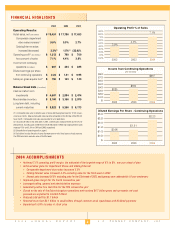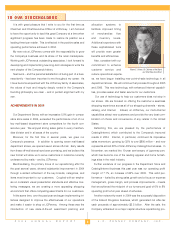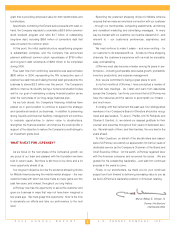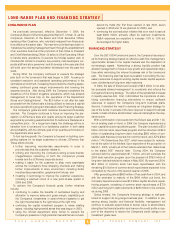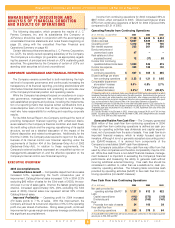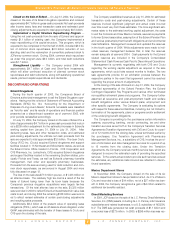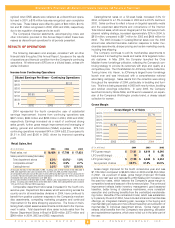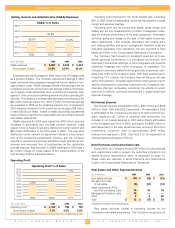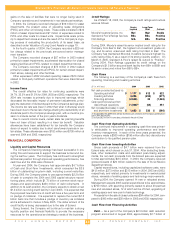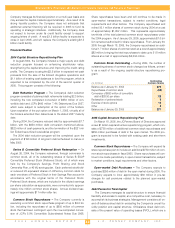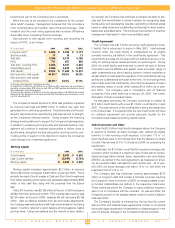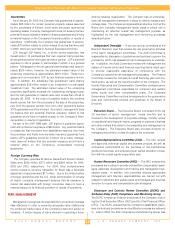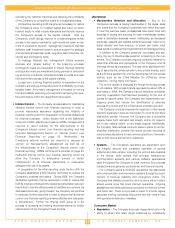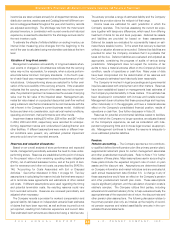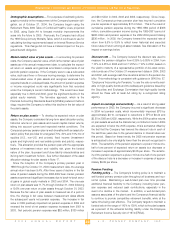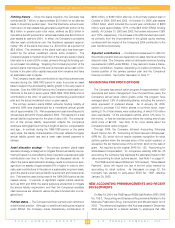JCPenney 2004 Annual Report Download - page 14
Download and view the complete annual report
Please find page 14 of the 2004 JCPenney annual report below. You can navigate through the pages in the report by either clicking on the pages listed below, or by using the keyword search tool below to find specific information within the annual report.
J.C. PENNEY COMPANY, INC.2 004 ANNUAL REPORT
Management’s Discussion and Analysis of Financial Condition and Results of Operations
12
Company manages its financial position on a multi-year basis and
may access the capital markets opportunistically. As a result of its
strong liquidity position, the Company does not anticipate that
additional external financing will be required in 2005 to fund its
operating or strategic initiatives. Additionally, the Company does
not expect to borrow under its credit facility except to support
ongoing letters of credit. A new $1.2 billion facility is expected to
close in April 2005, and will replace the Company’s existing $1.5
billion credit facility.
Financial Position
2004 Capital Structure Repositioning Plan
In August 2004, the Company initiated a major equity and debt
reduction program focused on enhancing stockholder value,
strengthening the capital structure and improving the credit rating
profile. The Company is using the $3.5 billion in expected net cash
proceeds from the sale of the Eckerd drugstore operations and
$1.1 billion of existing cash balances to fund the program, which is
expected to be completed by the end of the second quarter of
2005. This program consists of the following:
Debt Reduction Program –
The Company’s debt reduction
program consisted of planned debt retirements totaling $2.3 billion,
including the now completed conversion of $650 million of con-
vertible debt and JCP’s $400 million 7.4% Debentures Due 2037,
which were subject to redemption at the option of the holders.
Upon expiration of the put option on March 1, 2005, virtually all of
the holders extended their debentures to the stated 2037 maturity
date.
During 2004, the Company reduced debt by approximately $1.7
billion, with the $650 million debt conversion mentioned above,
$822 million of cash payments, and the termination of the $221 mil-
lion Eckerd securitized receivables program.
The 2004 debt reduction program will be completed upon the
payment of $193 million of long-term debt scheduled to mature in
May 2005.
Series B Convertible Preferred Stock Redemption
–
On
August 26, 2004, the Company redeemed, through conversion to
common stock, all of its outstanding shares of Series B ESOP
Convertible Preferred Stock (Preferred Stock), all of which were
held by the Company’s Savings, Profit Sharing and Stock
Ownership Plan, a 401(k) savings plan. Each preferred stockhold-
er received 20 equivalent shares of JCPenney common stock for
each one share of Preferred Stock in their Savings Plan account in
accordance with the original terms of the Preferred Stock.
Preferred Stock shares, which are included in the diluted earnings
per share calculation as appropriate, were converted into approxi-
mately nine million common stock shares. Annual dividend sav-
ings will approximate $11 million after tax.
Common Stock Repurchases –
The Company currently is
executing a common stock repurchase program of up to $3.0 bil-
lion, including the repurchase of up to $650 million of common
stock that had been contingent upon the now-completed conver-
sion of JCP’s 5.0% Convertible Subordinated Notes Due 2008.
Share repurchases have been and will continue to be made in
open-market transactions, subject to market conditions, legal
requirements and other factors. The Company repurchased and
retired 50.1 million shares of common stock during 2004 at a cost
of approximately $1,952 million. This represents approximately
two-thirds of the total planned common stock repurchases under
the 2004 program. As of January 29, 2005, approximately $1.0 bil-
lion remained authorized for share repurchases. From January 30,
2005 through March 18, 2005, the Company repurchased an addi-
tional 1.7 million shares of common stock at a cost of approximately
$82 million, bringing the total repurchases to date up to 51.8 million
shares at a cost of approximately $2,034 million.
Common Stock Outstanding
–
During 2004, the number of
outstanding shares of common stock changed as follows, primari-
ly as a result of the ongoing capital structure repositioning pro-
gram:
Outstanding
(in millions)
Common Shares
Balance as of January 31, 2004
274
Repurchases of common stock
(50)
Conversion of $650 million of convertible
debt at $28.50 per share
23
Redemption of preferred stock
9
Exercise of stock options
13
Other
2
Balance as of January 29, 2005
271
2005 Capital Structure Repositioning Plan
On March 18, 2005, the JCPenney Board of Directors approved
anew $1 billion capital structure repositioning program, which con-
sists of $750 million of additional common stock repurchases and
$250 million purchases of debt in the open market. The 2005 pro-
gram is expected to be funded with existing cash and short-term
investments.
Common Stock Repurchases –
The Company will expand its
share repurchase plan to include an additional $750 million of com-
mon stock repurchases in fiscal 2005. Share repurchases will con-
tinue to be made periodically in open-market transactions, subject
to market conditions, legal requirements and other factors.
Open-market Debt Purchases
–
The Company expects to
purchase $250 million of debt in the open market during 2005. The
Company expects to incur approximately $30 million in pre-tax
charges for call premiums related to the planned open-market
purchases.
Debt Percent to Total Capital
The Company manages its capital structure to ensure financial
flexibility and access to capital, at a competitive cost, necessary to
accomplish its business strategies. Management considers all on-
and off-balance sheet debt in evaluating the Company’s overall liq-
uidity position and capital structure. Off-balance sheet debt con-
sists of the present value of operating leases (PVOL), which are a


